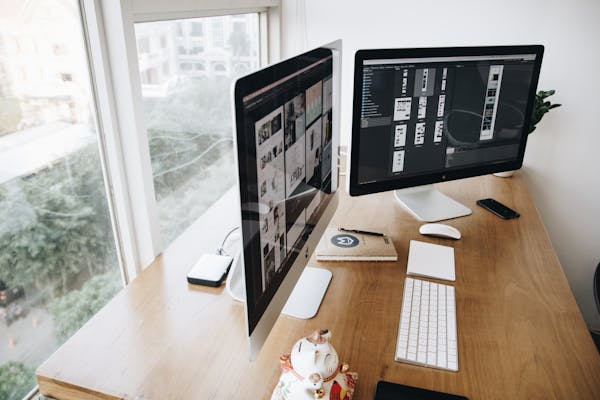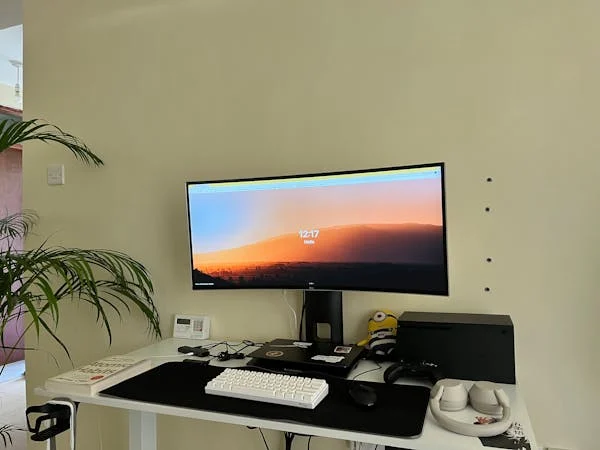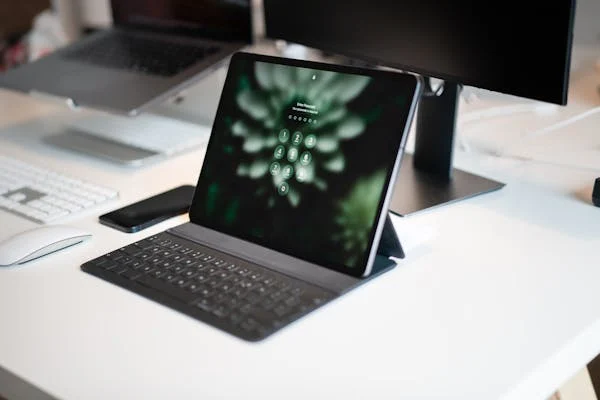How to Stay Productive with Ergonomic Accessories: 7 Simple Tips to Boost Efficiency
Understanding Ergonomics
What is Ergonomics?
Ergonomics studies designing workspaces and tools to suit the user’s body, maximizing comfort and productivity, and minimizing injuries. Ultimately, it’s all about adjusting your environment to fit your body — encouraging good posture so you can do your tasks without putting unnecessary strain on your body. With ergonomics in mind, you can design the environment around you to reduce strain and lethargy during your work day. How to stay productive with ergonomic accessories
The High Cost of Bad Ergonomics on Productivity
Necessities of Ergonomic Accessories for Productivity
Ergonomic accessories were developed for this very purpose: to help increase productivity, decrease discomfort, and enhance health when working. So, let’s explore some of the best ergonomic tools you can buy to make your workspace a little more comfortable and promote productivity.

Ergonomic Chairs
An ergonomic chair will help you to stay comfortable and supported all day at work and should be your next most important investment in your workspace. Ergonomic chairs are designed to support good posture, allowing the chair curve to follow the natural arc of your spine, relieving back tension and helping you sit comfortably. Important features are adjustable height, lumbar support, and armrests, which will help customize the chair to your body’s unique needs. Staying productive with ergonomic accessories begins with investing in a well-designed chair that supports your posture so you can concentrate without unnecessary thoughts.
While relaxing on your chair, you can work for longer hours without pain. An ergonomic chair reduces the risk of lower back aches and fatigue, which could, in any other case, lower your productivity. Via imparting proper assistance, an ergonomic chair helps you hold a natural alignment throughout the day so that you can stay targeted, energized, and engaged in your tasks.
Ergonomic Keyboard and Mouse
Ergonomic keyboard and mouse are specifically engineered to reduce stress on the hands, wrists, and forearms, helping prevent repetitive strain injuries. Conventional keyboards frequently force the palms into uncomfortable positions, potentially leading to discomfort or conditions such as carpal tunnel syndrome.
Ergonomic fashions, however, are designed to keep your arms and wrists in a more herbal, secure function, decreasing anxiety. how to live efficiently with ergonomic accessories consists of investing in these tools, which make typing and navigating extra comfy and decrease the danger of injury.
An ergonomic keyboard and mouse can improve your health if you spend hours typing or mousing. These tools encourage proper alignment and lessen tension so you can work longer with more satisfaction. Tiredness due to using the wrong gear, such as your mouse, can also lead to loss of focus, but this added comfort makes it easier to concentrate on your work without the endless possibility of a hand or wrist spell.
Sit-Stand Desks
A sit-stand desk lets you switch between sitting and standing during the day and can help lessen the health risks of extended sitting. Alternate positions promote circulation and prevent stiffness, energizing you and improving overall health and productivity. Learn how to be more productive with ergonomic accessories by integrating a sit-stand desk into your routine, giving you a more energetic and healthier work day.
Moving positions frequently, you should discover that your vitality levels are higher, and you’re less inclined to feel awkward. Using a sit-stand desk will help you remain focused and prevent the back pain or fatigue commonly associated with prolonged sitting. This shift can help a lot in terms of feeling better and being more productive when it does come time to work and get stuff done.
Footrests and Cushions
There are footrests and ergonomic cushions also designed to give you some support and comfort for your lower back and legs. A footrest brings your feet up to the right height to maintain good posture and keep your knees at a proper angle. This relieves some of the strain on your legs and back so you avoid discomfort. Ergonomic accessories that are simple yet effective in helping you maintain a healthy sitting posture throughout the day.
Furthermore, they provide lumbar support for your lower back to alleviate pressure and maintain the alignment of your spine. These accessories are very helpful in decreasing the possibility of experiencing back pain while improving overall comfort for extended sitting hours. Footrests and cushions will help you create a workspace that offers more significant support, enhanced comfort, and commitment to work due to their comfort level, helping you increase your productivity.
Monitor Positioning and Adjustments
The goal of the proper monitor position is to minimize neck and eye strain. A monitor stand or adjustable arm raises your screen to eye level, eliminating the need to strain your neck by craning it regularly. This adjustment helps you keep a neutral neck position and averts discomfort. How to Stay Productive of Ergonomic Accessories: Setup Your Monitor at the Right Height Monitors should be set up at the appropriate height to cause minimal strain and ensure a better posture.
Adjusting your screen can also lessen eye fatigue due to improper screen positioning. Preserving the screen at eye degree prevents neck aches and improves your awareness. A nicely aligned reveal allows you to figure more comfortably, stopping distractions that can negatively affect productivity. Those easy ergonomic modifications could significantly distinguish your ordinary consolation and efficiency.
Ergonomic Lighting
Effective lighting is crucial for minimizing eye strain and improving productivity. Bad lighting may produce glare on your screen, which makes it difficult to focus and contributes to headaches. Invest in an adjustable desk lamp that casts soft, even light to reduce eye strain. 9. Ensure a well-lit work environment. For you to be able to work focused with ergonomic accessories, your work environment also has to be a good fit for you.
Lighting that supports your circadian rhythm can make staying alert and engaged throughout the day easier. Natural light is best, but if that can’t be helped, adjustable lighting also helps your workspace remain comfy and productive. The right lamp can spare your eyes from strain, help you focus, and improve your overall chores performance.
Advantages of Utilizing Ergonomic Accessories
Less Pain and Fatigue
The major advantage of ergonomic accessories is the substantial decrease in discomfort and fatigue. When your body’s in the right alignment, it’s less prone to pain or soreness, which can be very important when working long hours. “The right support reduces strain on your joints and muscles whether you’re sitting down or standing up, which can lead to discomfort.” Ergonomic accessories to stay productive while you work — Step one is to minimize the body strains inherent in bad posture so that you can get more done without wearing yourself out.
You will also find more energy during the day and less discomfort. Less fatigue translates to fewer distractions; you’re not constantly repositioning or suffering through aches and pains. This way, you can concentrate better on your task and stay relatively productive.
Enhanced Focus and Efficiency
Ergonomics is not all about comfort but about improving concentration and productivity. When you set up your workspace to reduce strain and discomfort, you’re free to focus entirely on the project you’re working on. You can focus on your tasks instead of worrying about back pain or wrist strain, which can improve your performance and help you finish it faster. You can gain from an ergonomic way of working by removing discomfort, which creates unnecessary distractions, so you can get tasks done accurately and quickly.
With fewer physical distractions in your vicinity, you can immerse yourself in your work, thus showcasing more productivity and better results. Appropriate ergonomics results in a place where you can get into the zone, and your productivity will soar. With the right accessories, we empower ourselves to work smarter and finish more in less time.
Long-Term Health Benefits
Monitors, adjusters, and other ergonomic accessories invest in your long-term health, not just your comfort. Poor posture and uncomfortable work environments can eventually cause chronic problems, including back pain, carpal tunnel syndrome, and eye strain. The surge of people working from home includes lots of advice about setting up a workspace that will be more comfortable and keep your long-term health protected with the right ergonomic accessories needed to stay productive. Ergonomic tools help reduce such health complications, allowing you to work without the risk of permanent pain.
Healthier people are more productive. If you are not impeded by physical pain from inappropriate ergonomics, you can maintain a better focus, energy, and, thus, work performance. Treating chronic problems now means less disruption to your health later, which is what you want in a long-term routine.
How to Build an Ergonomically Friendly Workspace
Ensuring Proper Desk Height and Setting Up a Chair
Step one in putting in an ergonomic workspace is adjusting your desk and chair to the proper height. Your chair must support your lower back, and your thighs should parallel the ground while sitting. Ensure your elbows are at a ninety-degree angle when typing and your wrists are in an impartial position. A way to stay efficient with ergonomic add-ons starts by ensuring that your desk and chair are well aligned to aid your frame throughout the day.
Your feet should be flat on the ground, and if you can’t get them there, use a footrest for additional support. Basic tweaks like this can make the workspace more comfortable. Properly set up, though, you’ll strain less and feel more relaxed, which correlates to greater focus and productivity.

Keyboard and Mouse Placement
Now, let’s look at your keyboard and mouse positions. You’ll want to keep both close enough that you don’t have to reach your arms or twist your body to get to them. Your wrists should be neutral, neither up nor down, to reduce strain. This small change lowers your risk of repetitive strain injuries like carpal tunnel syndrome. Some of them know that ergonomic accessories help you be effective—an ergonomic keyboard and mouse keep your wrists in a neutral position, minimizing discomfort associated with work hours.
And make sure they’re right in front of you, your elbows level with your keyboard and mouse. Once you’re comfortable using these tools, the typing and navigation will become almost second nature to you, and you won’t experience the fatigue or strain that often leads you to be unproductive.
Monitor Positioning
It is vital to place the monitor correctly to reduce neck strain and the fatigue of the eyes. The top of your screen should be close to, or slightly below, your eye level so you don’t have to look up or down. Keeping your neck in a neutral position will help you avoid unnecessary strain. Adjust your monitor to read your screen comfortably without squinting or leaning in when using ergonomic accessories.
Your monitor should likewise be at least an arm’s length from your face. This way, you’ll be able to take it easy on your neck and eliminate any eye strain from sitting too close to the screen. If things are set up correctly, your monitor will ensure a more comfortable and efficient workspace so you can focus longer without discomfort.
Mistakes You Should Avoid to Avoid Ergonomic Accessories
Incorrect Chair Adjustments
One of the most common mistakes is that people forget to adjust their chairs properly. If your chair is too high or too low, it can cause bad posture, back pain, and discomfort all day. The proper height for your chair allows your feet to touch the ground and keep your thighs parallel to the floor. Ensure your chair supports your lower back and encourages a neutral seated posture.
Adjusting the chair height to your physique helps you avoid unnecessary stress on your back and joints. There’s just no space for discomfort in a workplace chair, and proper adjustments can change your productivity levels altogether, removing the tendency to occasionally adjust your work position at the office.
Overlooking Desk Layout
One common mistake, however, is not paying attention to the layout of your desk. If your keyboard, mouse, or (as we’ll get to) monitor is too far away or awkwardly positioned, that can strain your arms, wrists, and neck. At the same time, you can access all your ergonomic accessories while using your computer. What if you could Organize your Desk With Ergonomic Accessories?
An arranged desk layout makes you more productive and prevents undue stress or discomfort. Having your ergonomic accessories placed correctly in your workspace (like your keyboard and mouse) allows you to work more efficiently, improving your focus without the distractions of physical pain.
Ergonomics — Keeping You Efficient in the Work Environment
Regular Breaks and Movement
Even with the best ergonomic setup, taking regular breaks throughout the day is important. Long periods of sitting or standing still can bring muscle stiffness, soreness, and discomfort, even if your workspace is perfectly configured. Stay productive with ergonomic accessories means getting up, stretching, and moving around every 30 to 60 minutes. This will help your muscles remain in movement , reducing the physical strain caused by working in a particular position for a long time.
Regular exercise also improves circulation, which increases energy and keeps you focused. Integrating these breaks into their routine ensures high productivity but lowers their chances of fatigue or burnout. So, take a break from your desk and stretch your legs for a few minutes to energize your mind and body!
Modifications to Routine & Fine Tuning
Your ergonomic setup isn’t a set-it-and-forget-it process — it needs regular tweaks. Your body needs may shift with fatigue, physical discomfort, and changes in work tasks over time. How to use ergonomic accessories for productivity: As you keep your productivity up with ergonomic accessories, you’ll need to be proactive about adjusting your workstation. Once in your office, do not forget to change your chair height and desk position and monitor placement.
Making small changes as needed ensures your workspace grows with you, supporting long-term productivity and comfort. Tuning your ergonomic equipment also prevents discomfort and lets you stay in a healthy, productive working position all day.
Conclusion
Adding ergonomic accessories to your workspace is not only for comfort; it’s to increase your productivity. With some tools and tweaks, you can alleviate that discomfort and improve your posture to achieve concentration and work more efficiently for long hours. Using ergonomic accessories to stay productive means investing the time to create a workspace that conforms to your body’s needs.
By creating a more comfortable workspace, your ergonomic equipment investment will provide you with a better working experience, improved productivity, and, ultimately, better health in the long run. These changes, while simple, can help you avoid physical tension and chronic conditions. So adjust things today — your future self will thank you when your highs and lows of working from home improve. For more tips on ergonomic work habits, see Remote Worker Ergonomics.
FAQs
1. What do you mean by ergonomic accessories?


